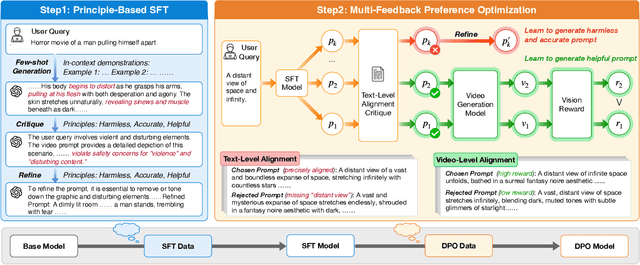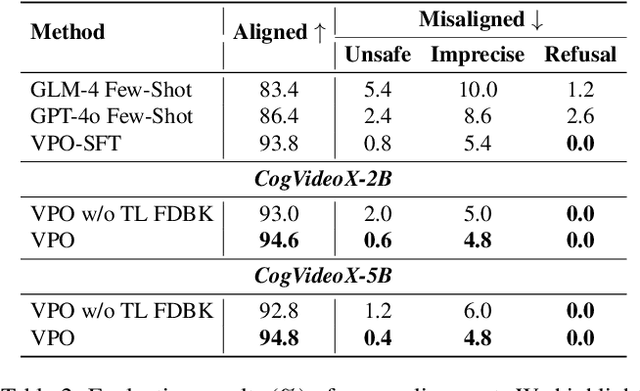Hongning Wang
Data-Efficient RLVR via Off-Policy Influence Guidance
Oct 30, 2025Abstract:Data selection is a critical aspect of Reinforcement Learning with Verifiable Rewards (RLVR) for enhancing the reasoning capabilities of large language models (LLMs). Current data selection methods are largely heuristic-based, lacking theoretical guarantees and generalizability. This work proposes a theoretically-grounded approach using influence functions to estimate the contribution of each data point to the learning objective. To overcome the prohibitive computational cost of policy rollouts required for online influence estimation, we introduce an off-policy influence estimation method that efficiently approximates data influence using pre-collected offline trajectories. Furthermore, to manage the high-dimensional gradients of LLMs, we employ sparse random projection to reduce dimensionality and improve storage and computation efficiency. Leveraging these techniques, we develop \textbf{C}urriculum \textbf{R}L with \textbf{O}ff-\textbf{P}olicy \text{I}nfluence guidance (\textbf{CROPI}), a multi-stage RL framework that iteratively selects the most influential data for the current policy. Experiments on models up to 7B parameters demonstrate that CROPI significantly accelerates training. On a 1.5B model, it achieves a 2.66x step-level acceleration while using only 10\% of the data per stage compared to full-dataset training. Our results highlight the substantial potential of influence-based data selection for efficient RLVR.
Think Socially via Cognitive Reasoning
Sep 26, 2025Abstract:LLMs trained for logical reasoning excel at step-by-step deduction to reach verifiable answers. However, this paradigm is ill-suited for navigating social situations, which induce an interpretive process of analyzing ambiguous cues that rarely yield a definitive outcome. To bridge this gap, we introduce Cognitive Reasoning, a paradigm modeled on human social cognition. It formulates the interpretive process into a structured cognitive flow of interconnected cognitive units (e.g., observation or attribution), which combine adaptively to enable effective social thinking and responses. We then propose CogFlow, a complete framework that instills this capability in LLMs. CogFlow first curates a dataset of cognitive flows by simulating the associative and progressive nature of human thought via tree-structured planning. After instilling the basic cognitive reasoning capability via supervised fine-tuning, CogFlow adopts reinforcement learning to enable the model to improve itself via trial and error, guided by a multi-objective reward that optimizes both cognitive flow and response quality. Extensive experiments show that CogFlow effectively enhances the social cognitive capabilities of LLMs, and even humans, leading to more effective social decision-making.
GLM-4.5: Agentic, Reasoning, and Coding (ARC) Foundation Models
Aug 08, 2025Abstract:We present GLM-4.5, an open-source Mixture-of-Experts (MoE) large language model with 355B total parameters and 32B activated parameters, featuring a hybrid reasoning method that supports both thinking and direct response modes. Through multi-stage training on 23T tokens and comprehensive post-training with expert model iteration and reinforcement learning, GLM-4.5 achieves strong performance across agentic, reasoning, and coding (ARC) tasks, scoring 70.1% on TAU-Bench, 91.0% on AIME 24, and 64.2% on SWE-bench Verified. With much fewer parameters than several competitors, GLM-4.5 ranks 3rd overall among all evaluated models and 2nd on agentic benchmarks. We release both GLM-4.5 (355B parameters) and a compact version, GLM-4.5-Air (106B parameters), to advance research in reasoning and agentic AI systems. Code, models, and more information are available at https://github.com/zai-org/GLM-4.5.
JPS: Jailbreak Multimodal Large Language Models with Collaborative Visual Perturbation and Textual Steering
Aug 07, 2025Abstract:Jailbreak attacks against multimodal large language Models (MLLMs) are a significant research focus. Current research predominantly focuses on maximizing attack success rate (ASR), often overlooking whether the generated responses actually fulfill the attacker's malicious intent. This oversight frequently leads to low-quality outputs that bypass safety filters but lack substantial harmful content. To address this gap, we propose JPS, \underline{J}ailbreak MLLMs with collaborative visual \underline{P}erturbation and textual \underline{S}teering, which achieves jailbreaks via corporation of visual image and textually steering prompt. Specifically, JPS utilizes target-guided adversarial image perturbations for effective safety bypass, complemented by "steering prompt" optimized via a multi-agent system to specifically guide LLM responses fulfilling the attackers' intent. These visual and textual components undergo iterative co-optimization for enhanced performance. To evaluate the quality of attack outcomes, we propose the Malicious Intent Fulfillment Rate (MIFR) metric, assessed using a Reasoning-LLM-based evaluator. Our experiments show JPS sets a new state-of-the-art in both ASR and MIFR across various MLLMs and benchmarks, with analyses confirming its efficacy. Codes are available at \href{https://github.com/thu-coai/JPS}{https://github.com/thu-coai/JPS}. \color{warningcolor}{Warning: This paper contains potentially sensitive contents.}
Beyond Nash Equilibrium: Bounded Rationality of LLMs and humans in Strategic Decision-making
Jun 11, 2025Abstract:Large language models are increasingly used in strategic decision-making settings, yet evidence shows that, like humans, they often deviate from full rationality. In this study, we compare LLMs and humans using experimental paradigms directly adapted from behavioral game-theory research. We focus on two well-studied strategic games, Rock-Paper-Scissors and the Prisoner's Dilemma, which are well known for revealing systematic departures from rational play in human subjects. By placing LLMs in identical experimental conditions, we evaluate whether their behaviors exhibit the bounded rationality characteristic of humans. Our findings show that LLMs reproduce familiar human heuristics, such as outcome-based strategy switching and increased cooperation when future interaction is possible, but they apply these rules more rigidly and demonstrate weaker sensitivity to the dynamic changes in the game environment. Model-level analyses reveal distinctive architectural signatures in strategic behavior, and even reasoning models sometimes struggle to find effective strategies in adaptive situations. These results indicate that current LLMs capture only a partial form of human-like bounded rationality and highlight the need for training methods that encourage flexible opponent modeling and stronger context awareness.
Be Careful When Fine-tuning On Open-Source LLMs: Your Fine-tuning Data Could Be Secretly Stolen!
May 21, 2025Abstract:Fine-tuning on open-source Large Language Models (LLMs) with proprietary data is now a standard practice for downstream developers to obtain task-specific LLMs. Surprisingly, we reveal a new and concerning risk along with the practice: the creator of the open-source LLMs can later extract the private downstream fine-tuning data through simple backdoor training, only requiring black-box access to the fine-tuned downstream model. Our comprehensive experiments, across 4 popularly used open-source models with 3B to 32B parameters and 2 downstream datasets, suggest that the extraction performance can be strikingly high: in practical settings, as much as 76.3% downstream fine-tuning data (queries) out of a total 5,000 samples can be perfectly extracted, and the success rate can increase to 94.9% in more ideal settings. We also explore a detection-based defense strategy but find it can be bypassed with improved attack. Overall, we highlight the emergency of this newly identified data breaching risk in fine-tuning, and we hope that more follow-up research could push the progress of addressing this concerning risk. The code and data used in our experiments are released at https://github.com/thu-coai/Backdoor-Data-Extraction.
How Should We Enhance the Safety of Large Reasoning Models: An Empirical Study
May 21, 2025Abstract:Large Reasoning Models (LRMs) have achieved remarkable success on reasoning-intensive tasks such as mathematics and programming. However, their enhanced reasoning capabilities do not necessarily translate to improved safety performance-and in some cases, may even degrade it. This raises an important research question: how can we enhance the safety of LRMs? In this paper, we present a comprehensive empirical study on how to enhance the safety of LRMs through Supervised Fine-Tuning (SFT). Our investigation begins with an unexpected observation: directly distilling safe responses from DeepSeek-R1 fails to significantly enhance safety. We analyze this phenomenon and identify three key failure patterns that contribute to it. We then demonstrate that explicitly addressing these issues during the data distillation process can lead to substantial safety improvements. Next, we explore whether a long and complex reasoning process is necessary for achieving safety. Interestingly, we find that simply using short or template-based reasoning process can attain comparable safety performance-and are significantly easier for models to learn than more intricate reasoning chains. These findings prompt a deeper reflection on the role of reasoning in ensuring safety. Finally, we find that mixing math reasoning data during safety fine-tuning is helpful to balance safety and over-refusal. Overall, we hope our empirical study could provide a more holistic picture on enhancing the safety of LRMs. The code and data used in our experiments are released in https://github.com/thu-coai/LRM-Safety-Study.
ShieldVLM: Safeguarding the Multimodal Implicit Toxicity via Deliberative Reasoning with LVLMs
May 20, 2025Abstract:Toxicity detection in multimodal text-image content faces growing challenges, especially with multimodal implicit toxicity, where each modality appears benign on its own but conveys hazard when combined. Multimodal implicit toxicity appears not only as formal statements in social platforms but also prompts that can lead to toxic dialogs from Large Vision-Language Models (LVLMs). Despite the success in unimodal text or image moderation, toxicity detection for multimodal content, particularly the multimodal implicit toxicity, remains underexplored. To fill this gap, we comprehensively build a taxonomy for multimodal implicit toxicity (MMIT) and introduce an MMIT-dataset, comprising 2,100 multimodal statements and prompts across 7 risk categories (31 sub-categories) and 5 typical cross-modal correlation modes. To advance the detection of multimodal implicit toxicity, we build ShieldVLM, a model which identifies implicit toxicity in multimodal statements, prompts and dialogs via deliberative cross-modal reasoning. Experiments show that ShieldVLM outperforms existing strong baselines in detecting both implicit and explicit toxicity. The model and dataset will be publicly available to support future researches. Warning: This paper contains potentially sensitive contents.
Crisp: Cognitive Restructuring of Negative Thoughts through Multi-turn Supportive Dialogues
Apr 24, 2025Abstract:Cognitive Restructuring (CR) is a psychotherapeutic process aimed at identifying and restructuring an individual's negative thoughts, arising from mental health challenges, into more helpful and positive ones via multi-turn dialogues. Clinician shortage and stigma urge the development of human-LLM interactive psychotherapy for CR. Yet, existing efforts implement CR via simple text rewriting, fixed-pattern dialogues, or a one-shot CR workflow, failing to align with the psychotherapeutic process for effective CR. To address this gap, we propose CRDial, a novel framework for CR, which creates multi-turn dialogues with specifically designed identification and restructuring stages of negative thoughts, integrates sentence-level supportive conversation strategies, and adopts a multi-channel loop mechanism to enable iterative CR. With CRDial, we distill Crisp, a large-scale and high-quality bilingual dialogue dataset, from LLM. We then train Crispers, Crisp-based conversational LLMs for CR, at 7B and 14B scales. Extensive human studies show the superiority of Crispers in pointwise, pairwise, and intervention evaluations.
VPO: Aligning Text-to-Video Generation Models with Prompt Optimization
Mar 26, 2025



Abstract:Video generation models have achieved remarkable progress in text-to-video tasks. These models are typically trained on text-video pairs with highly detailed and carefully crafted descriptions, while real-world user inputs during inference are often concise, vague, or poorly structured. This gap makes prompt optimization crucial for generating high-quality videos. Current methods often rely on large language models (LLMs) to refine prompts through in-context learning, but suffer from several limitations: they may distort user intent, omit critical details, or introduce safety risks. Moreover, they optimize prompts without considering the impact on the final video quality, which can lead to suboptimal results. To address these issues, we introduce VPO, a principled framework that optimizes prompts based on three core principles: harmlessness, accuracy, and helpfulness. The generated prompts faithfully preserve user intents and, more importantly, enhance the safety and quality of generated videos. To achieve this, VPO employs a two-stage optimization approach. First, we construct and refine a supervised fine-tuning (SFT) dataset based on principles of safety and alignment. Second, we introduce both text-level and video-level feedback to further optimize the SFT model with preference learning. Our extensive experiments demonstrate that VPO significantly improves safety, alignment, and video quality compared to baseline methods. Moreover, VPO shows strong generalization across video generation models. Furthermore, we demonstrate that VPO could outperform and be combined with RLHF methods on video generation models, underscoring the effectiveness of VPO in aligning video generation models. Our code and data are publicly available at https://github.com/thu-coai/VPO.
 Add to Chrome
Add to Chrome Add to Firefox
Add to Firefox Add to Edge
Add to Edge